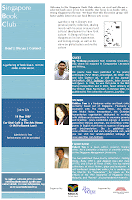
Last week I attended two "talks" at the Arts House in Singapore. The first one was by the author, Satish Kumar (http://en.wikipedia.org/wiki/Satish_Kumar) and the other by a young man, Yi-sheng Ng.
The environment of the two sessions were so very different. Satish in his 60s seriously talked about his adventure of walking for world peace, without a penny in his pocket, as he walked into hostile Pakistan from India. That hostility seemed only in politics, as he was immediately invited for food and lodging by a stranger, who heard about his objective.
Soon, he alongside with a friend has gone round the world, ending in the USA. During this trip, he was entrusted four packets of tea by a lady in Russia, to be given one each to the President of Russia, France, the USA, and the Prime Minister of England. When the president of France refused to see them, they protested in front of the Elysee Palace. For that they were imprisoned for a few days. He finally got his packet delivered.
In England he met the person who inspired the walk, Betrand Russell. Finally, he delivered all the four packets of tea, and he continues with his work in England.
The talk was humourous but comprehensible. It was a tale of courage. It was above all a belief that was put into action with no idea how the future could turn out to be. It was indeed motivating to me.
Yi-sheng is a young man (http://en.wikipedia.org/wiki/Ng_Yi-Sheng) who is so different in perspective. He read his poems by rapping and with actions. This is different from what I would expect from poems reading. He was enthusiastic about his work. I could hardly understand the meaning of the poems as he rapidly rapped through them.
What is the insight in both of these sessions? Surely diversity is the key theme. Diversity in expressions and in thinking brings about creativity and discoveries which could amaze us, if only we are opened to areas that are stranger to us.
As a manager, it is so easy to say, "my way, or the bye way" which is so common these days. "If you disagree with my thinking, you will have to go" to say it in plain language. Yet the argument that if the company has two of the same kind, would it not be cheaper and more efficient just to have one? Surprisingly, the fundamental is often missing in even good companies.
Managing diversity in opinions is a balance between speed to decision and distance from quality. If difference is not tolerated, the quality of the decision will suffer. If the difference is not well managed, the quality of the decision will not improved either. Hence the competency to manage the outcome of diversity of opinions will not only bring out both the facts and emotion of it, but the passion to follow through with real actions.
In my corporate life, I have seldom seen this competency. Those whom I have seen continue to be leaders in their own right, not due to an imposition of office bestowed on them. It is the understanding of what it truly takes to be a leader, instead of an office bearer, that will create the environment where you can produce your best.
I remember fondly the HP Way, which paraphrases as "a person will do his or her best, if provided with the right environment and the right tool." This universal truth is the vision of the founding fathers of the company. Reinforce it with another truth, "trust and respect the individual" as no one is the same as the next, and you can fully appreciate the power of managing diversity.
Comments